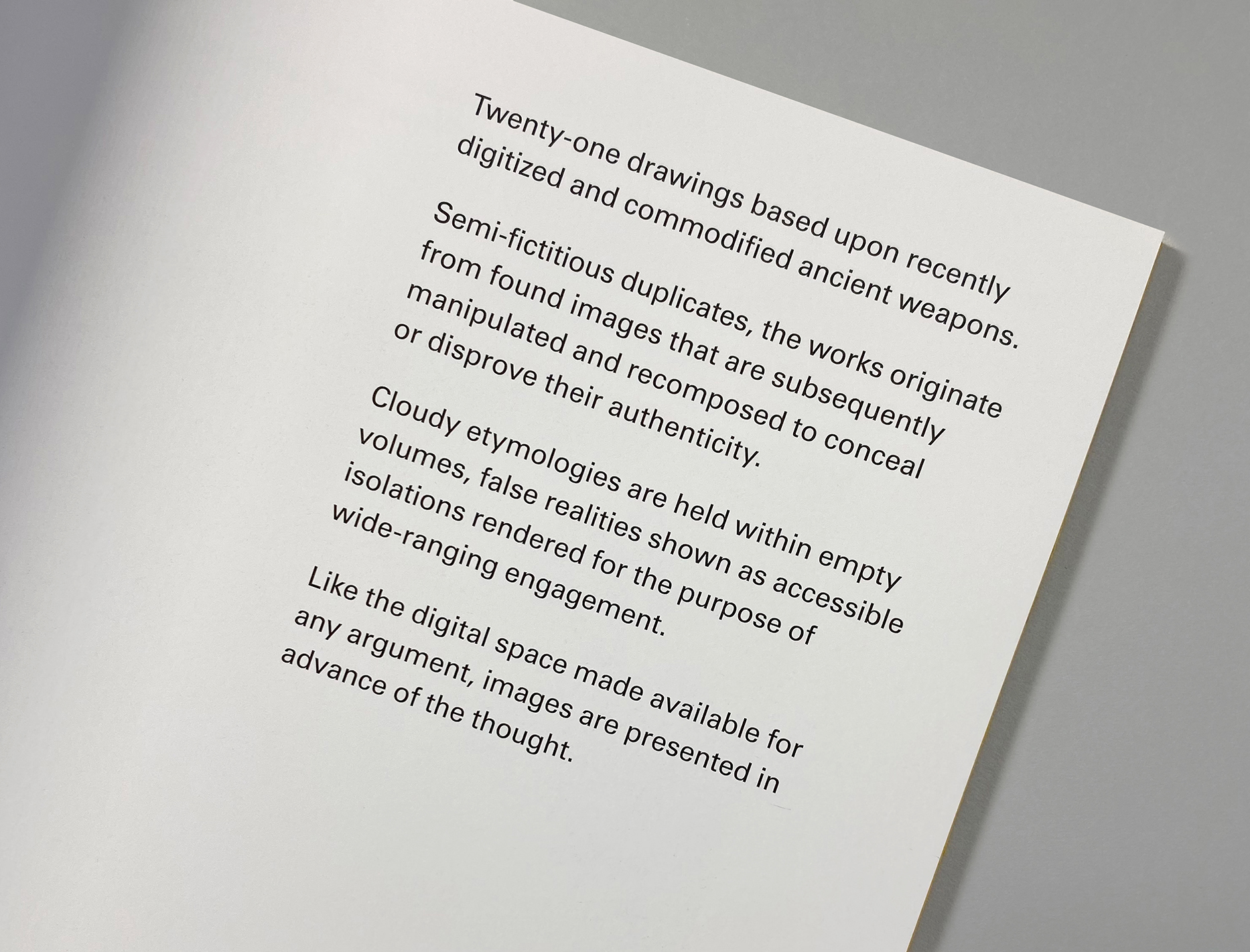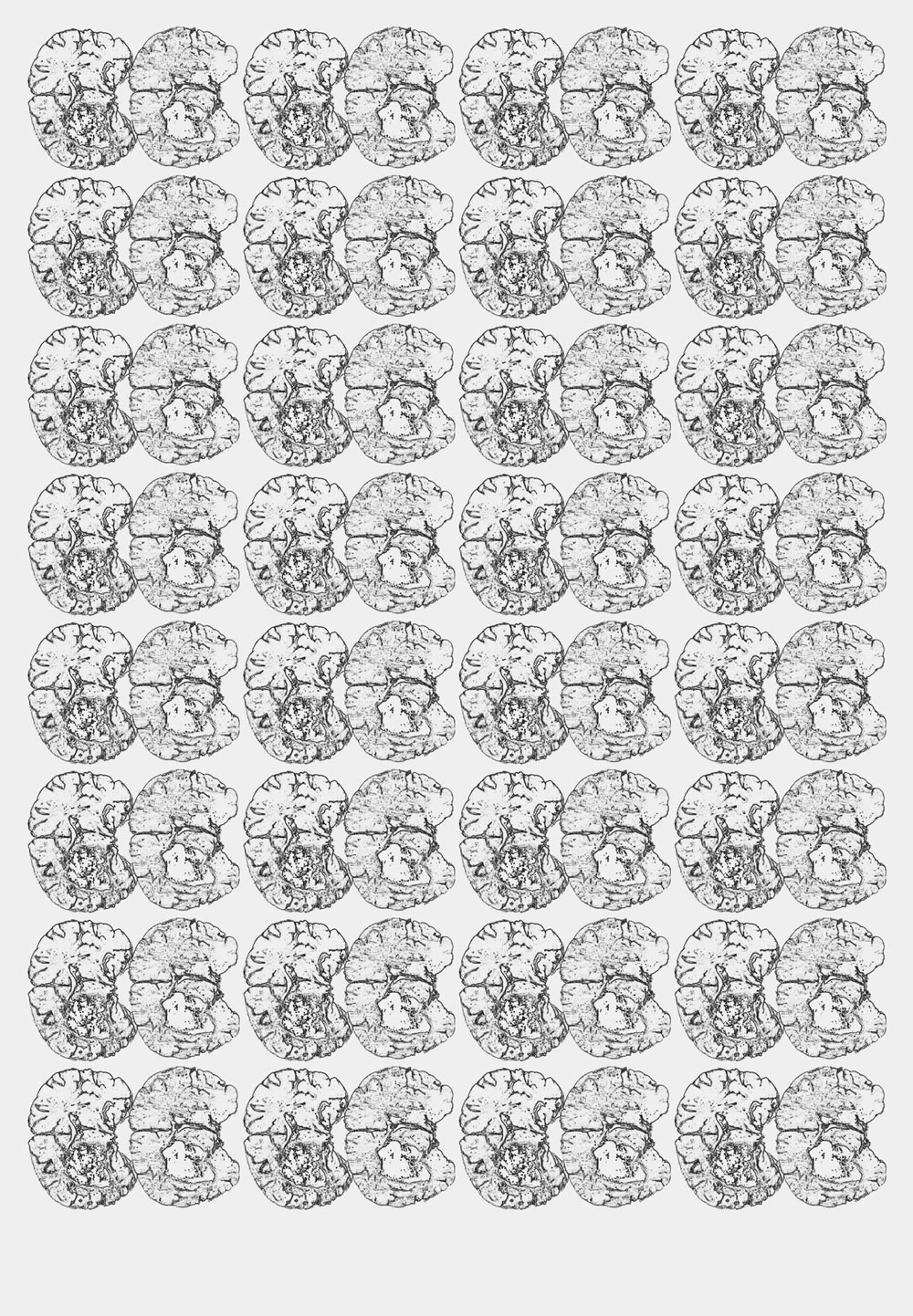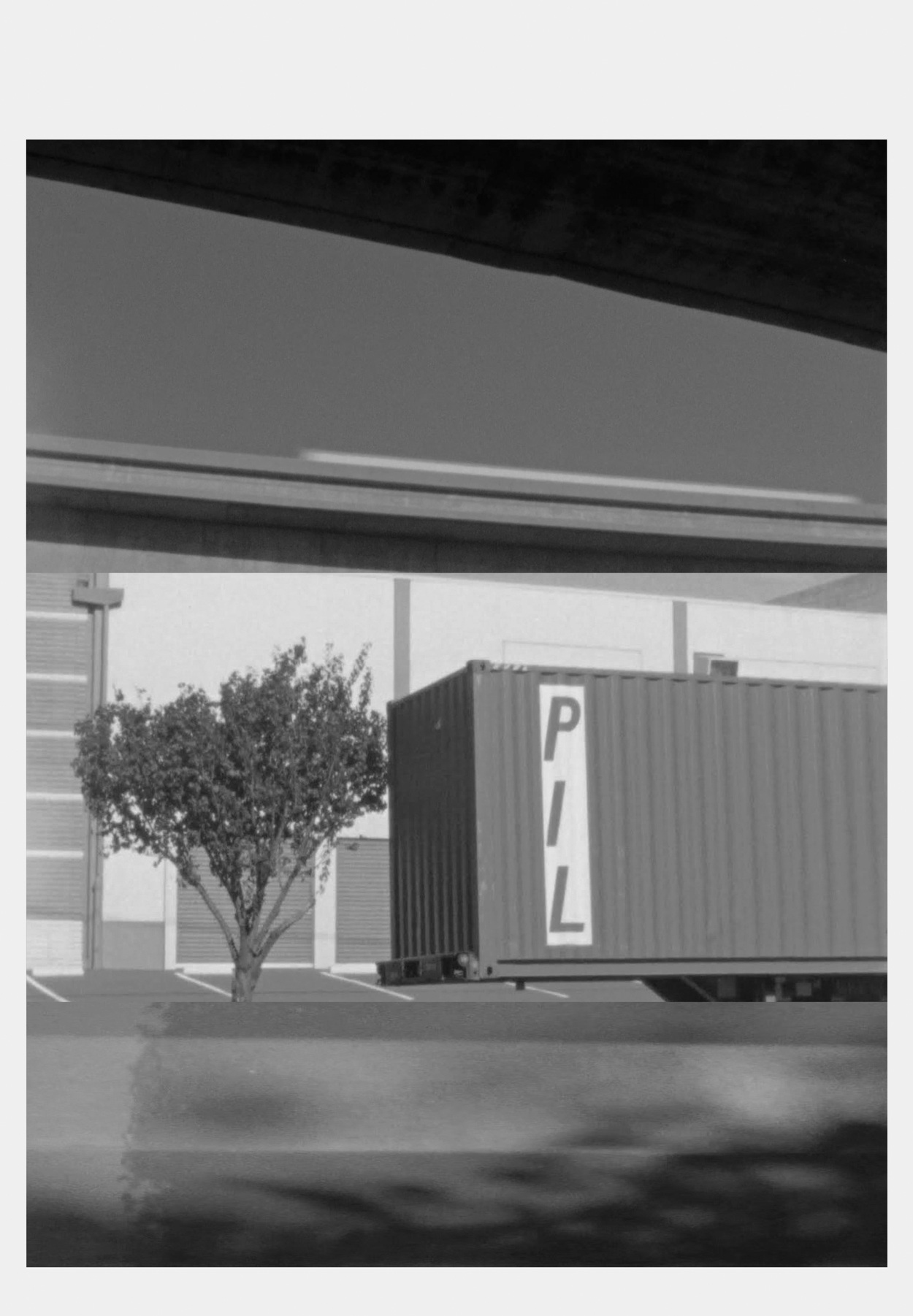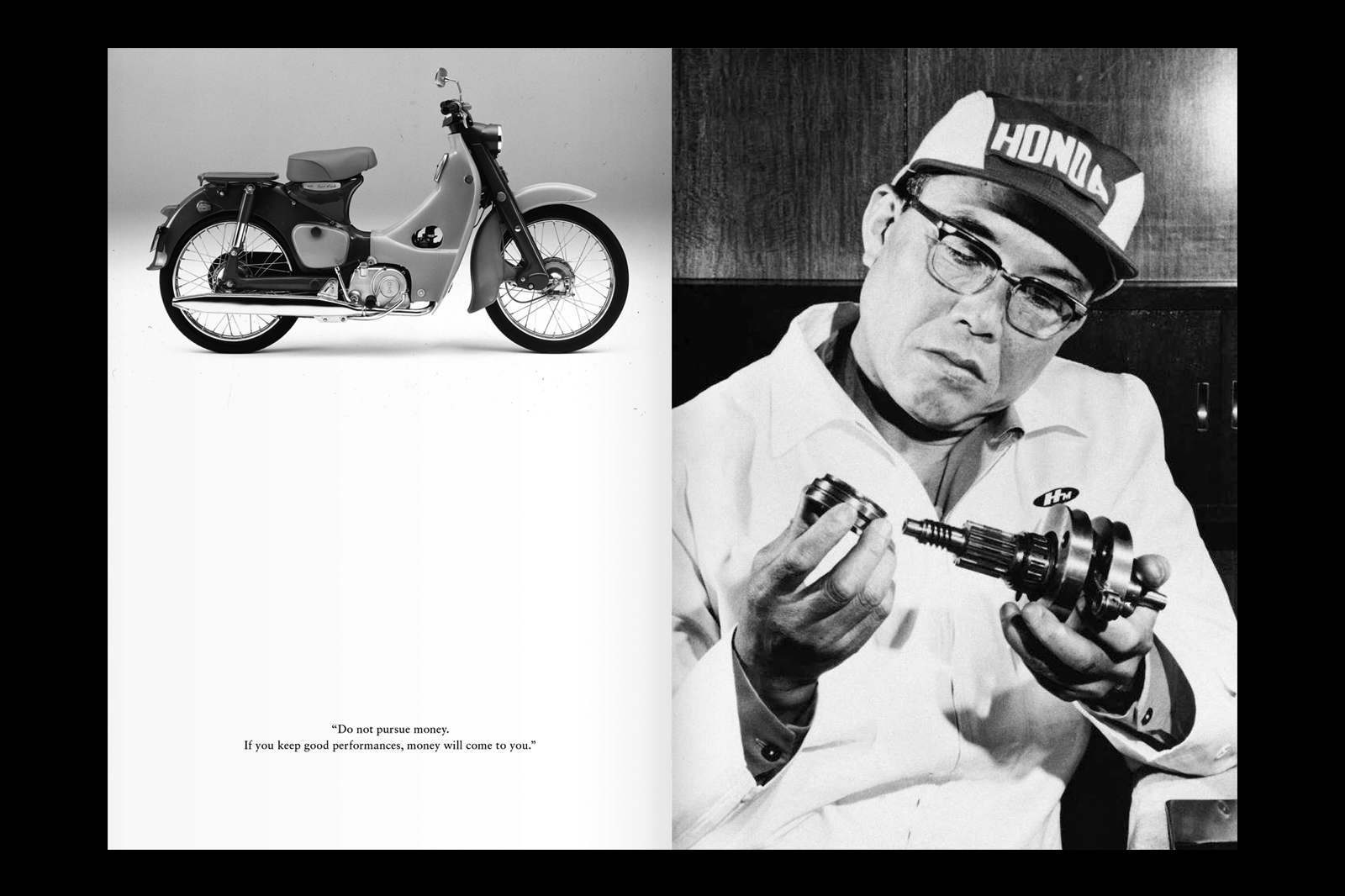A Lying Man
Zyrland Editions

A Lying Man
Hand finished woodcut
(Ink and coloured pencil on paper.)
Edition of 20, plus 5 APs
19.5 x 15.75” / 50 x 40 cm
2023
$250.00 (Including shipping)
Released by Zyrland Editions, A Lying Man is a hand-finished woodcut that appropriates illustrations from twentieth-century religious textbooks and nineteenth-century folk tales.
Each print is finished with coloured pencil and ink, and is printed on archival Mohawke Superfine paper.
To purchase, please email: zyrlandzoiropa@gmail.com
—
Weapons
Limited Edition Artist’s Book


Created during a period of lockdown, Weapons is a limited edition artist’s book featuring twenty-one new drawings and accompanying texts.
The works, all pencil on paper, originate from found images that have been subsequently manipulated and recomposed to conceal or disprove their authenticity.
50 pages. Softcover, foil embossed.
23 x 17 cm / 9 x 6.75”.
Design: Andrew Bell, Glasgow.
Photography: On White Wall, Brooklyn.
Print: die Keure, Bruges.
Stock: G.F Smith Colorplan / Arctic Volume.
ISBN 978-0-578-89232-0
Edition of 500.
$5.00 US / EU / UK shipping.
Worldwide orders, please email: info@liamallan.com
© 2021 Liam Allan
Available at: Printed Matter, New York and Good Press, Glasgow.
—
Publications for Commuters
2018 – Present
Limited edition newsprint publications featuring artist’s writing and imagery, distributed on the nyc subway and at selected locations internationally.
Katie Schwab, Louise Giovanelli, Calum Craik, Liam Allan, John Ryaner, Alex Allan.

Louise Giovanelli, An Ex IV.
Limited edition publication for commuters.
Newsprint, 20 x 27.5". 2019.
NYC Subway / Frankfurt am Main. Edition of 200.
A statement of the state.
My concern is to foreground ways of looking and perceiving, to encourage the possibility that the act of looking itself is content. I deploy cultural references and excerpts from other art forms to investigate the languages and histories of painting. These Images are identified intuitively for their subsequent painterly potential. This has recently included various visual phenomena such as light effects and surface textures. The process of synthesis is gradually distilled through an associative process of placing, replacing, collaging and drawing - providing scope for them to fall away, settle and mature. This allows for the possibility that something will be created rather than illustrated.
I navigate different modes of picturing - flat, modelled, effervescent, translucence - employing multiple modes within the same painting as well as dispersed over several connected works.
Configurations of intersecting under/overlaps might encourage the viewer to switch between different patterns of looking.
Recent work comprises black-modelled leaves in various configurations.
The historically reoccurring motif of the Acanthus leaf suggests something classical, decorative, and ornamental.
I exploit its connotations as simplistic, anodyne decoration, to explore more purposeful visual ideas.
The black paintings consider the act of drawing - into and on top of.
Sculptural volume is manipulated to form indentation lines. These lines connect one corner to another and delineate space.
This produces a framework, which allows for a consideration of function.
The motif or ‘idea’ of a leaf encourages subsequent visual ideas.
They are visual wanderings. They portray a visual ‘thinking through’, in order to encourage ‘seeing in’.
The paintings are accumulations of interruptions - pauses, false starts, and fragmented clues.
Deliberate obfuscation complicates legibility. I am interested in the process of excavation that ensues (during making and viewing) and how this might translate into a sensation of compression and decompression.
My work is not autobiographical, a consequence of my beliefs or psyche – it is a result of things noticed, measured and assembled.
The paintings refuse to give into the idea of the scriptic authorial touch. They are not about me; they are through or of me.
I am interested in paintings’ autonomy – a consideration of the thing itself rather than reading into what is not there. I preference the sensorial - seeing into as opposed to projecting onto. The works are a gentle confrontation.
They are not demands. They are suggestions.
—


Katie Schwab, Moquette.
Limited edition publication for commuters.
Newsprint, 20 x 27.5". 2019.
NYC Subway / St Ives. Edition of 100.
Katie's text is an abstracted arrangement of a quote from a 1968 interview between Cynthia Weaver and the English artist and designer Enid Marx. [Published in Weaver’s Enid Marx: Designing Fabrics for the London Passenger Transport Board in the 1930s, Journal of Design History, Volume 2, Issue 1, 1 January 1989.]
—

John Ryaner, Untitled.
Limited edition publication for commuters.
Newsprint, 20 x 29". 2018.
NYC Subway / Frankfurt am Main. Edition of 100.
A man woke up one morning and for no reason whatsoever started removing his organs. He started with a kidney.
After scraping with a fingernail he slid an index finger into the side of his belly, gouging through squidging layers of fat and fatty liquids. He fiddled through intestines until he felt the cool purplishbrown of the kidney and twisted it out from the renal veins and artery. Gripping his hand around the adrenal gland, he poked his fingers through the cortex and medullas and yanked - he tore the kidney away from the urethra and urine squirted everywhere. The removal of the second kidney was more fluid and when he was done he moved straight onto the liver. Fat and heavy, you could almost see the gravity, a real fucking slug. Halved by hepatic veins, a lobe so big it overshadowed one side with deep shades of purple. You wouldn’t fit a hand around it. Fingers reached around the coronary ligament and reaped faliciform from the ligamentum terres. He pulled his arm out of his body and dumped a liver on the floor, then quickly put his arm back inside and shuffled his hand through other organs. Tearing the skin he pushed his forearm deep inside his solar plexus. His shoulder at the edge of the opening of the hole in the middle of the man, his whole arm fully inside of himself, deep. He moved his arm upwards and wrapped it around a lung, pulling it out in one great swoop. Mucus and thick blood spurted out the bronchus, a lung lost air as it fell to the floor. The extracted organs were lying on the ground and covered in gunk, the room reeking of urea, bile, sweat, and steam rised from the smelling liquid. The next organ he went for was the testicles. The best route was through the penis. He stuck an index finger deep into his urethral opening, inside from the tip to the knuckle. The hole was tight but he shoved, then followed with another finger. Once both fingers were deep inside he pushed his distal phalanx against the interior of the corpus cavanosa. His foreskin tore. His frenulum snapped. He ripped his penis in half. His glands were leaking pints of blood, his feet became submerged. As the fascias of the penis started pulling apart, prejaculation fluid gushed down his legs, white and transparent. When the penis was halved he forced his hands through the corpus spongiosum, snook his way into the scrotum and grabbed a right testicle with a left hand, a left testicle with a right hand, and in one great movement using his whole body he flung his arms right up into the air, his testicles thrown to the sky and mashed against the ceiling. Semen exploded everywhere. It landed in his hair. It clogged his pores. It wet his follicles. It dripped down his face, some of it landing in his tears and congealing then falling to the floor in coalesced gooey lumps. He reached for the bladder, soft and silklike in texture, contrast with the glass like smoothness of the strong testicles, he threw it on the floor. After stamping on the bladder he took a deep breath then went back for a second lung. Pulling it hard he tore it in half, bronchioles spilling everywhere. Another half followed, a hard thug removing it from the tracheal cartilage. Deflated lungs collapsed on the floor like a pair of discarded urine bags, sagging with stems sticking out the sides gently leaking. He reached a hand passed the stomach and immersed the gallbladder in palm. He squeezed till the fundus and neck crushed into mush and streams of crud ran down his forearm. The cystic and bile ducts disconnected, a stomach removed, torn from esophagus and cardinal notch it flopped out over the belly and intestines came tumbling after, pouring out like a tin of spaghetti, totally messy but somehow contained, gooping with all sorts of biles, acidic juices and chyle, spilling on the floor, eroding and staining other organs, stinking. He plucked the appendix away from the large intestine, inflamed and disheveled as it was. He yanked a spleen, he broke a heart, he jerked a pancreas. He flung his organs across the room and when they hit the wall they slid to the floor, leaving a slime of blood, pancreatic juices and amniotic fluid trailing behind. The next organ he targeted was the skin, the largest organ. He began at the cuticles of the toenails. He pulled and he pulled and he pulled, the skin peeled back, he peeled and he peeled. He peeled back the skin all over his feet. He continued up the legs and up to the torso. His lower bones completely visible, the mechanics of the joints and muscles entirely revealed. He reached his hands behind his back as though to take off a sweater, all the way down to the thoracolumbar fascia. Persisting, flagellating, he began to remove the whole body of skin. He flayed from below until the entire sheet of skin was lifted above his head and with one last pull he snapped his forehead skin from his skull. The shell of skin flew up into the air and glided across the room. The fleece stuck against the wall, resembling a deflated person. His bonafide hands were now perfect for gouging out his eyes. He got a grip and squeezed them tight with the boney thumbs and middle fingers. His iris fell out, his lens disappeared, his pupil exploded. The eyes burst as they were crushed and intraocular fluid and aqueous humour flooded everywhere wettening everything they touched. Now with two dark and empty holes to see through, the final object was the brain. He pointed his hands into beaked shapes and entered through the sockets. When the hands were inside he wrapped them all the way around, they fit around the brain like a glove. He began clenching his fists and burying fingers deep into the brain. He buried them deeper then deeper. Once his fingery bones were deep in the temporal lobe he pulled the brain out through the sockets. Cerebrospinal fluid leaking everywhere. The brain ripped in two. Finally all of his organs had been removed. The man a mere skeleton of what he used to be. He took a long breath, he walked to the bathroom. he brushed his teeth then got on with the rest of his day.
—

Calum Craik, Invisible Hand/Flows.
Limited edition publication for commuters.
Newsprint, 20 x 29". 2018.
San Francisco MTA / NYC Subway. Edition of 100.
The semi-permeable barrier is lifted temporarily to allow the flow from the vast ocean.
An invisible hand operates the gate.
Local memory allows us to process this flow as we can imagine it being repeated in the past, so we accept the flow.
Our memory architecture familiarizes this process so we accept it as natural.
The flow is natural.
The speed of the flow is dictated by how quickly the queued vehicles are allowed access by cache hierarchy.
If the cache of goods travels a short distance then this is a cache hit.
If the cache is a miss then this may require and eviction to make room via the use of a cache policy.
The cache travels on elevated highways which branch across the landscape.
Scars and registrations guide the cache on the board.
The caches contents are often hidden.
The cache travels in often similar looking indistinguishable vessels.
Our enjoyment of the cache is often indistinguishable from our experience.
The invisible hand guides the flows, we guide the invisible hand.
The public image of the cache is nondescript yet the cache creates shadows and forms which appear natural.
The flow is natural.
The abstraction of the cache is partly due to its dematerialized form.
As the dematerialized form is not always visible we may accept it as not being there.
Older caches are still present but are much slower as they travel on older networks.
The older flows are associated with very foundations of the vast networks we see present today.
The cache stacks almost take form of structures themselves, resembling small cities. Yet access to these cities is limited.
The access is only permitted to special vessels.
The vast concrete branches are also accessible to the public yet the private networks dominate the space and flow.
Underneath the vast branches more cache is housed.
Waiting.
Waiting.
Waiting.
—

Liam Allan, Papier Mache.
Limited edition publication for commuters.
Newsprint, 20 x 29". 2017.
NYC Subway. Edition of 100.
A french detective called Papier Mâché sits at a large city centre bar drinking a ‘Tequila Mockingbird’. The bar is part of a national chain where managers and staff have little autonomy over the nature of their weekend promotions – in this case, individual bar staff are allowed to devise and name their own cocktails, although they have to consider a restrictive price point and a relatively conservative ingredients list. Collated sales results are viewed in a distant office and assessed to target customers’ preferred options, slowly eroding the list further.
There are over fifty venues in the group and they all share a similar array of sturdy, veneered furniture and lingeringly patterned carpets. Regional and sometimes highly specific themes are depicted in rhetorical phrases carefully painted on the wall and by generic, antiquated black and white photographs: a miner drinking a pint of Guinness, women in a factory, a 1960’s image of a local football team.
Their printed branding, portraying the luxury of genuine value for money as if it were a free bet offer from an online gambling company, depicts the three available options, suitably priced, for each category of drink.
People quietly judge each other as Papier Mâché leans towards the barmaid to ask, ‘What is this month’s imported continental lager?’, while pointing at the words on the menu instructing him to do so.
-
The detective orders a pint of the imported lager and it arrives in an overtly branded, crisply chilled glass – taller than the glasses that the other customers have, clean and brightly shining like rom-com sunlight through the dew covered window of an English country hotel.
"I'm on vacation!" Maché pronounces, turning from the bar to face the room.
"In fact, this is the first day of my retirement."
With his battleship grey trench coat, matching fedora and pencil moustache, Maché is detached from the expectations of the crowd, their silence in reply offering him no bridge to begin conversation – a suburban fear of anything other than small parameter repetition.
Pulling a large magnifying glass from his pocket, he raises the lens to his eye and stoically places it on the bar. In a subdued tone, without an audience, he addresses the bar:
"I was looking for something, that it is not there I must now accept. Forgotten images are in different photographs, lost maxims are renewed for different names; reality built out of fiction."
Staring into the distance, over the whirling detail of the interior, Maché remains alone, accompanied by after images burned into television screens.
—

Liam Allan, Swimmers.
Limited edition publication for commuters.
Newsprint, 20 x 29". 2017.
NYC Subway. Edition of 100.
Before its recent renovation, there was a large mural covering one wall of the local municipal swimming pool. Appearing under the brown tiling and warmly fluorescent lights, the image rose above the distant depth of the pool with an inviting permanence.
The mural depicted four or five sailboats in a restrained palette of earthy pastels and faded ochres, they were not immediately recognisable but the shape of their sails pointed towards the eighties in style and aspiration.
It was an enjoyable scene, a casual backdrop indicating the leisure of Mediterranean vacation, or, for the lane swimmers, a frame presumably placing them nearer to the world of luxury performance and sport.
If the water was split lengthways the lanes would only be given one eighth of the pool, on the far side next to the windows and the lifeguard. Within this space fit two fifty meter sections where the swimmers almost always wore swimming caps and goggles. Those whose aspirations went further added frequent glances towards a large LED clock measuring in milliseconds, a precision that would today be analysed in detail and more effectively. They would begin their lengths immediately, voluntarily allowing themselves only the water within one of the two fifty meter strips.
On Friday nights the lanes were replaced with dance music, inflatable obstacles and a giant slide.
—
Green Koi
2015


—